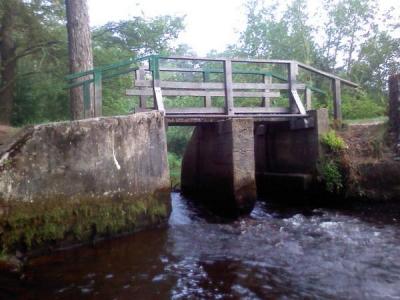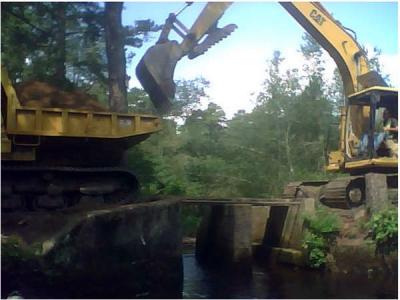Red Brook renewed


Lots has happened at Red Brook, but representatives of the Trustees of Reservations, Trout Unlimited, and the Wareham Land Trust offered a tour of the property on Saturday to show what wasn't there. After many years of partnership among the organizations and the A.D. Makepeace Company, Red Brook is starting to look like normal.
Naturalist Theodore Lyman III visited Red Brook in 1867 while working for the Massachusetts Board of Inland Fisheries. For the next 30 years, he acquired land on both sides of Red Brook, eventually owning a total of 638 acres. Six generations of Lymans used the area as a fishing camp for "salters," sea-run brook trout that live in fresh water from spring to fall, and spawn in the autumn before spending the winter in near-shore ocean waters.
Thanks to the Lymans, the stream is today one of the last habitats for these extra-large "brookies." In 2001, the Lyman family donated the entire Red Brook property to the Trustees of Reservations to ensure its protection in perpetuity.
But the stream itself has deteriorated since Lyman first visited.
Cranberry growers installed several dams to back up water for flooding the bogs. This has trapped sediment in the stream and smothered the gravel bottom needed for brook trout to lay their eggs.
The Lymans created wider and shallower pools in the stream and cut back undergrowth to provide better fishing holes for themselves -- and, effectively, for the fishes' feathered predators. They also divided the stream and rerouted it to form a "casting pool" where they could practice their skills.
But a new ethic has taken over.
Technology has reduced the cranberry industry's demand for water, and the environmental organizations have worked with A.D. Makepeace to restore the waterway's original condition.
The Robbins Dam was removed in 2006. It had been built by the Lymans during the 1960s drought in return for lifetime rights to hunt grouse on Makepeace land, according to Warren Winders, the Red Brook director for the Massachusetts and Rhode Island Council of Trout Unlimited. Harry's Dam was removed in 2008.
The stream was returned its initial channel and, in places, narrowed and deepened. Riverbanks were reinforced with earth. Some trees were felled into the stream to create habitat and hiding spots for fish. Silver maple, bayberry and other native trees and shrubs were planted along the banks to reinforce the earth and provide shade to keep the stream water cool enough for the sensitive trout.
And the brook trout are appreciative.
According to Winders, 84 trout were counted in 1999. 527 were counted last year, a success that has caught the attention of local environmental organizations.
"Brook trout will come back if you fix the habitat," Winders said. "This little stream has a lot of symbolic significance."















